#Monaghan County Council
Explore tagged Tumblr posts
Text
#OTD in 1957 – Death of Seán Sabhat and Feargal O'Hanlon; killed during a raid led by Sean Garland against an RUC Barracks in Brookeborough, Co Fermanagh.
Seán is mostly widely known as Seán South from Garryowen. There have even been several songs written to his honour under this misconception. In reality South was from O’Connell Avenue in Limerick, but due to the poetic license of Seán Costello also a Limerickman, he’ll forever be linked with Garryowen. Seán Sabhat, also known as Sean South, born in 1928, was shot down by the Royal Ulster…

View On WordPress
#An Fòrsa Cosanta Áitiúil#Border Campaign#Brookeborough#Co. Fermanagh#Dominic Behan#Feargal O&039;Hanlan#Flying IRA Column#IRA#Monaghan County Council#New Year&039;s Day#Pádraigín Uí Mhurchadha#RUC Barracks#Seán Garland#Seán Sabhat#Sinn Fein#The Irish Army Reserve#The Patriot Game
5 notes
·
View notes
Text
Oh, hello
The Sibyl of Tydavnet was supposedly back home, and we finally have something to speculate upon, after a week-end with no news from both of Them (go figure). So much so that it's been very, very quiet in here:

This is, of course, a latergram, When being the important question, here. I have to say I was a bit surprised, after two hours of research (and cooking, but that is a separate story).
Let's unpack:
From 1974 to 2023, the Monaghan County Museum has been open and free to visit. Until 1981, in the old Courthouse building of Monaghan Town, then temporarily hosted by the Christian Brothers Secondary School, and since 1986 in this building on Hill Street:

I am not inventing anything, this info comes straight from their official website:
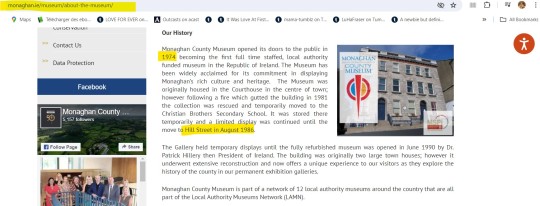
On May 18th, 2023 (on International Museum Day), the venue was closed and the collections were planned to be moved at the new Monaghan Peace Campus:
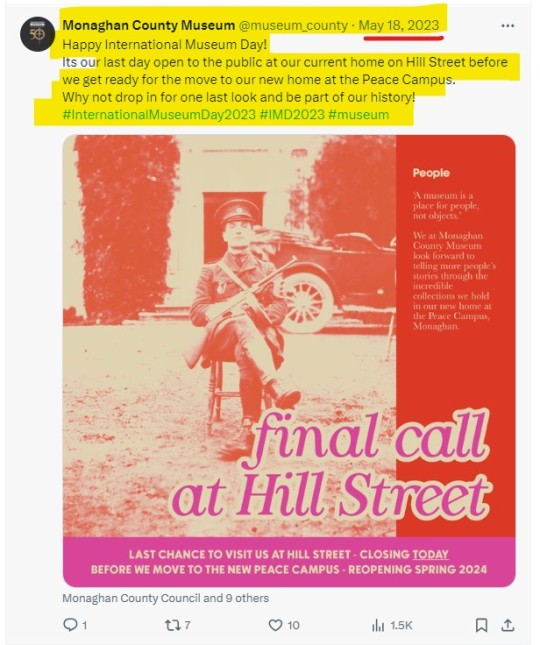
The Peace Campus is a very important local initiative, funded by the City Council, the Irish Department of Rural and Community Development and the EU, via the Irish SEUPB (Special EU Programs Body - ironically, the counterpart of my new job, starting next Friday, LOL). It was inaugurated on May 10, 2024:

Where was C, in this clip, posted today and suggesting a recent trip to Ireland?

In the old building, of course, exactly as it was on May 18, 2023:
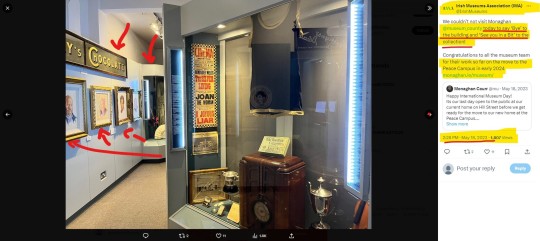
Apparently taken on an extensive private tour that included the storage area, where this pic was taken:

How do I know it? I simply combed the meager social media accounts of the Museum, that's all. See and compare for yourself, with this screenshot of the moving operations, from the old Hill Street to the new premises (posted on Facebook, on June 14th, 2024, but very likely shot slightly before):

In April 2023, the new Peace Campus looked roughly like this. There is no way that clip would have been shot there. Not then...
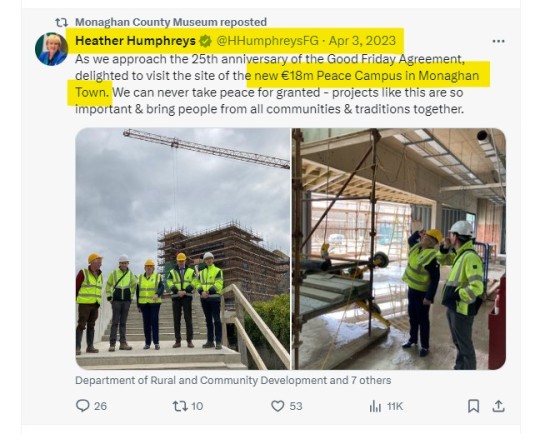
...and not later, because the new display in the new venue looks totally different:
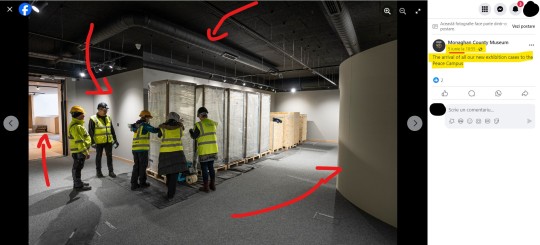
And it was completed around May 10th 2024, when this picture was taken, separately from the rest of the released info:

The pic was taken by Laura Hogan, the North East Correspondent for RTE News, a subsidiary of the Irish public TV and Radio broadcasting company:
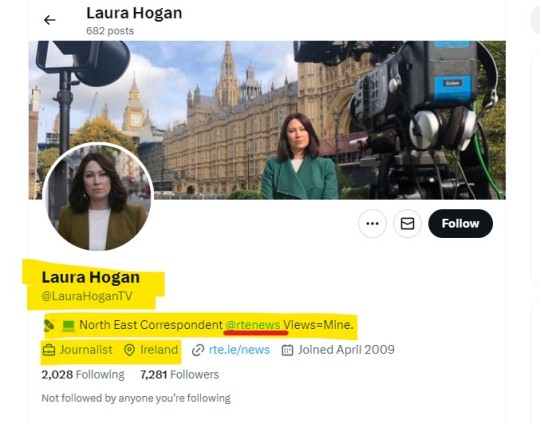
But perhaps even more interestingly, the Museum shot several clips of people featured, like C, in the new inaugural exhibition. Such as this guy, back in June 2023, on their old premises:
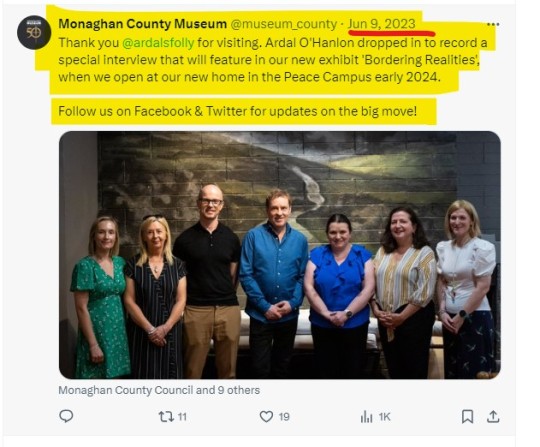
Ardal O'Hanlon, Irish stand-up comedian and actor, based in Ireland and London:
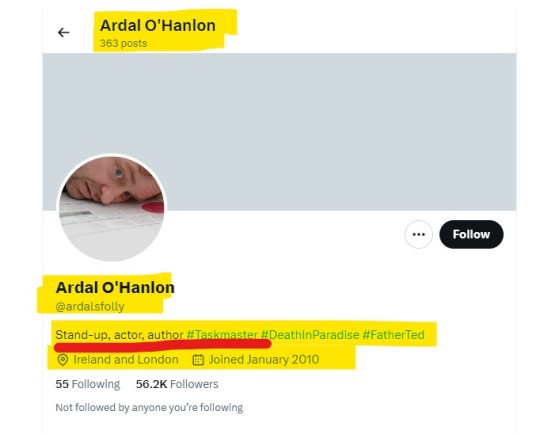
This is a very, very, VERY late latergram. My best guess would be anytime between May 2023 and most probably around June 2023. Simply because it would be logical that the clip shooting be completed with all the people involved at the same time, for logistical reasons, and before the packing of the exhibits would have started in earnest.
As always, I could be wrong. As always, people will bitch around, especially the divas and those who know strictly nothing. But I'll be damned if C were in Ireland anytime near this last week-end!
94 notes
·
View notes
Text
Nobody injured – but two cats and a chinchilla killed – in firebombing attack on Dublin house
New Post has been published on https://petn.ws/sHv3H
Nobody injured – but two cats and a chinchilla killed – in firebombing attack on Dublin house
Monaghan County Council and local Garda bosses have issued a joint appeal to motorists to obey road safety laws when travelling over the course of the Easter Bank Holiday weekend. Three animals were killed after a house was targeted in a firebombing in Dublin last night. An elderly woman also had to be rescued from […]
See full article at https://petn.ws/sHv3H #CatsNews #LatestNewsTicker
0 notes
Text
The Maltings Cultural Venue, Berwick
The Maltings Cultural Venue Berwick-upon-Tweed, RIBA architecture contest, UK Architect Design
The Maltings Cultural Venue, Berwick-upon-Tweed Competition
18 March 2022
Shortlist announced for design of The Maltings Cultural Venue, Berwick-upon-Tweed
Location: Eastern Lane, Berwick-upon-Tweed, Northumbria, North East England, UK – border with Scotland
photo courtesy of The Royal Institute of British Architects
The Maltings Cultural Venue Design Competition Shortlist
Northumberland County Council and The Maltings (Berwick) Trust have announced the shortlist for a RIBA Competition.
The competition is seeking a design team to deliver a landmark cultural attraction at the heart of Berwick-upon-Tweed. The venue will create a new focal point for visitors and residents, acting as a key driver for the culture-led regeneration of the town.
The existing Maltings venue is ageing, no longer fit for purpose, fails to exploit its unique river-view location, and presents ever-increasing operational challenges. The new Maltings will provide a high-profile visual symbol that will act as a significant catalyst for economic growth, job creation, renewed civic pride, destination tourism, creative and commercial development for Berwick-upon-Tweed.
Following the Competitive Procedure with Negotiation and evaluation of the Selection Questionnaire responses, a shortlist of five has been selected to take part in the design phase of the competition.
The shortlist is:
• Allford Hall Monaghan Morris Architects (AHMM) • Burrell Foley Fischer • Carmody Groarke • MICA Architects • Space Architects
RIBA Architect Adviser for the competition, Euan MacDonald from Hawkins\Brown, said: “It’s a privilege to support The Maltings and Northumberland County Council with such an engaging competition process, for this opportunity to enhance the cultural landscape, and wider regeneration of Berwick-upon-Tweed.
Evaluating the initial submissions was an intensive but hugely enjoyable process, which we’re delighted has resulted in such a creative and impressive shortlist. I’m sure the panel are as excited as I am to see how the teams respond to the brief and communicate their ideas for this unique project.”
The shortlisted teams will present their concept design proposals to the evaluation panel in June 2022.
Previously on e-architect:
16 December 2021
Design Competition launched for The Maltings Cultural Venue, Berwick-upon-Tweed
Location: The Maltings, Eastern Lane, Berwick-upon-Tweed, Northumbria, England, UK
The Maltings Cultural Venue, Berwick-upon-Tweed Design Competition
The Royal Institute of British Architects (RIBA) is pleased to announce the launch of a new design competition following the ‘Competitive Procedure with Negotiation’ on behalf of Northumberland County Council and The Maltings (Berwick) Trust.
The competition is seeking a multi-disciplinary design team to deliver a landmark cultural attraction at the heart of Berwick-upon-Tweed, creating a new focal point for visitors and residents’ and acting as a key driver for the culture-led regeneration of the town.
The Maltings (Berwick) Trust is the primary cultural organisation in this area of the county, operating across three separate venues in the centre of Berwick. They are a key social, cultural and educational hub for the town, and the only professional cinema across a large rural catchment across North Northumberland and the eastern Scottish Borders.
The Maltings current Eastern Lane venue is no longer fit for purpose and the Maltings (Berwick) Trust has worked in partnership with Northumberland County Council to secure Borderlands Inclusive Growth Deal funding to deliver a 21st century venue on the existing site.
The competition is seeking applications in response to an initial brief in the form of a completed Selection Questionnaire. It is anticipated that up to five teams will be shortlisted and invited to participate in the design phase of the competition.
Ros Lamont, Executive Director The Maltings (Berwick) Trust commented: “The launch of this design competition is an exciting and hugely significant moment for the Maltings and our partners – and a crucial stage in realising our long term ambitions. Our firm intention is that a striking new venue will serve as a beacon for culture and creativity across our region, exceed audiences’ and artists’ expectations of an accessible 21st century public space, and provide a thriving home for a year round programme of outstanding arts experiences.”
Applications are invited in accordance with the requirements set out in the brief and selection questionnaire. Further information can be found on the competition webpage at https://ift.tt/9tcvuZp including a link to the competition documents from Northumberland County Council.
The deadline for receipt of applications is 14.00hrs on Monday 24 January 2022.
The Maltings Cultural Venue, Berwick-upon-Tweed Design Competition images / information from RIBA 161221
Address: Eastern Ln, Berwick-upon-Tweed, TD15 1AJ, England, United Kingdom Phone: 01289 330999
Location: Berwick-upon-Tweed, Northumberland, North East England, UK
Newcastle Architecture
Contemporary Newcastle Buildings
Newcastle Architecture Designs – chronological list
Berwick-upon-Tweed Flats Design: Malcolm Fraser Architects image courtesy of architects practice Berwick-upon-Tweed Flats
Northumbrian building image : www.pb-imaging.com
Newcastle Architecture – Selection
Sage Design: Foster + Partners photo © Adrian Welch Sage Gateshead
Millennium Bridge photo © Adrian Welch Millennium Bridge
Newcastle College : Music, Performing Arts & Media Centre Design: RMJM Architects Newcastle College
Website: Visit Berwick
Comments / photos for the The Maltings Cultural Venue, Berwick-upon-Tweed Design Competition – Northumbrian architecture contest page welcome
The post The Maltings Cultural Venue, Berwick appeared first on e-architect.
0 notes
Photo

‘Vidēte, Patrēs, ut ērādīcētis schismam Hussitārum.’ Latin for: ‘See ye to it, O Fathers, that ye eradicate the Hussite Schism.’ ‘See ye to it, O Bishops, that ye eradicate the Hussite Schism.’ (my translation) The English word: ‘to eradicate’ means, etymologically: ‘to tear something up by the roots’. ‘ē’ in Latin is a preposition that means: ‘out’ and ‘rādīx’ genitive singular: ‘rādīcis’ is a Latin 3rd-declension noun that means: ‘root’. Thankfully, we are no longer in the 15th century, and Christians no longer go about gleefully eradicating each other. The Roman Catholic Church can no longer call upon the German Army to annihilate a competing sect thanks to secularism; thanks to the New Idea that is Freedom of Religion; thanks to the separation of Church and State. The Roman Catholic Church only embraced the novel concept that is Religious Freedom in the 1960s. Prior to that time it was condemned heresy. As a cultural Christian and as a cultural Catholic, I embrace secularism. Secularism guarantees freedom of and from religion for all. As a Catholic, I have absolutely no desire to eradicate those who disagree with me on religious matters. In his pamphlet on promoting Republicanism, the late Christopher Hitchens (1949-2011) says that those men who are worshipped as gods—i.e. Christian Ministers—ought not to be let within an ass’s roar of civil power. Perhaps in saying this, Hitchens had in mind the Catechism of the Council of Trent (1566), which says explicitly that Roman Catholic priests are gods. #history #christianity #latin #translation #secularism #language #education (at County Monaghan) https://www.instagram.com/p/CY9WlW5tUc0/?utm_medium=tumblr
0 notes
Text
Information Dump 1 - Why Women Got the Vote in 1928
ID: 1 Level: Higher (National 6) Topic: Why Women Got the Vote in 1928 Broader Section: Britain 1851-1951 Factor: Changing Attitudes (Factor 1) Note on text: Normal text is knowledge, italicised is Analysis and bolded is Evaluation. These are all important in constructing an essay so if you're taking notes separate them with highlighter colours or write at the side of your book a K, A or E so you know! Bold and italics is Historiography.
Women were generally seen as being less intelligent than men and over all were considered inferior. During this time women in working, middle and upper classes had few rights and were expected to be loyal wives and attentive mothers rather than getting a job or were alternatively expected to work as maids or in other domestic jobs, the middle classes may work as Governesses for example. Overall, they were generally considered inferior; many believed that there was something just completely different about women and men and that’s what caused this view, this was something believed by both men and women.
This began to change as the 19th century progressed.
In 1857 a new law was brought in that meant women could get divorced if they husbands were cruel or had left them. Furthermore, by 1870 it had become law that women were able to keep the money they earned rather than it becoming the husband’s money. By 1895, women had the right ot become the sole guardian of their child if their husband died, previously the children had gone to the closest male relative. These laws meant that women now had much more autonomy and rights, while also being seen as a shift in how society perceived women as a whole.
As time continued, women became active in public affairs and were allowed to vote for a variety of local positions including: school board positions, county councils and Parish and District councils. They could also become members of political organisations. “their participation in local Government made women’s exclusion from national decisions increasingly untenable.” - Martin Pugh This meant that the law against women voting in General Elections was beginning to become outdated and less rational as their involvement in local government continued.
Furthermore, more opportunities began to spring up in education, for example the first university college for women was set up in 1870. Even as early as 1848, Queen’s college was founded as a training institute for female teachers. Under a decade after the first full-fledged (i.e. not just instructing teachers) was founded, a similar college would be founded at Oxford. By the closing years of the 19th century, women were being enrolled into Universities on the same standing as men. Additionally, the Education Act (1880) enforced that all girls between 5 and 10 had to attend school, leading them being more educated overall and were more likely to be able to enter more professions.
These new professions included teaching, law, social work and medicine and by moving into originally male-centric professions women were challenging and changing the attitude of the time. Between 1861 and 1911 there was a 307% increase in the employment of women in non-manual jobs, however 97% of female office workers were still payed less than men. Additionally, trade union membership among women rose dramatically between 1870 and 1914 and they achieved great improvements to pay and conditions but still lagged behind men considerably.
When considering the vast changes that occurred, it becomes clear that women’s role in 19th century Britain was changing drastically. [Millicent] Fawcett, leader of the Suffragists, argued that these changes were essential to winning the franchise. It was clear that winning this was not happening however, and a more active campaign was needed. McGonigle and Kerr argued that the overall affect “was to erode male prejudices” Morrison, Morrison and Monaghan say “By the end of the Victorian era there is no doubt that the cause of women’s rights had made significant progress. Yet, in the key areas of voting rights women remained outsiders.”
5 notes
·
View notes
Text
0 notes
Text
Local Authority Environmental Performance Assessment Report 2014-2016 Monaghan County Council
http://dlvr.it/QKntL5
0 notes
Text
#OTD in 1957 – Death of Seán Sabhat and Feargal O'Hanlon; killed during a raid led by Sean Garland against an RUC Barracks in Brookeborough, Co Fermanagh.
#OTD in 1957 – Death of Seán Sabhat and Feargal O’Hanlon; killed during a raid led by Sean Garland against an RUC Barracks in Brookeborough, Co Fermanagh.
Seán is mostly widely known as Seán South from Garryowen. There have even been several songs written to his honour under this misconception. In reality South was from O’Connell Avenue in Limerick, but due to the poetic license of Seán Costello also a Limerickman, he’ll forever be linked with Garryowen. Seán Sabhat, also known as Sean South, born in 1928, was shot down by the Royal Ulster…

View On WordPress
#An Fòrsa Cosanta Áitiúil#Border Campaign#Brookeborough#Co. Fermanagh#Dominic Behan#Feargal O&039;Hanlan#Flying IRA Column#IRA#Monaghan County Council#New Year&039;s Day#Pádraigín Uí Mhurchadha#RUC Barracks#Seán Garland#Seán Sabhat#Sinn Fein#The Irish Army Reserve#The Patriot Game
6 notes
·
View notes
Text
Delight at launch of major cross-border greenway project
27 February 2018 ,
Government officials from Northern Ireland and the Republic of Ireland came together yesterday in Co Donegal for the official launch of the North West Greenway Network. The €14.85m project is one of the biggest infrastructure projects ever undertaken in the north west of Ireland which will deliver 46.5km of new cross-border greenway.
A unique element of the project is that Sustrans has appointed an Active Travel Officer who will undertake an engagement programme with local schools, workplaces and communities to raise awareness of the greenway, before and during its construction, and encourage commuters to swop their cars for cycling and walking.
Derry City & Strabane District Council, Donegal County Council, the Northern Ireland Department for Infrastructure (DfI) and Sustrans will work in partnership on the project. It has been funded under the EU’s INTERREG VA Programme, managed by the Special EU Programmes Body (SEUPB).
Match-funding for the project has been provided by the DfI and the Department of Transport, Tourism and Sport in the Republic of Ireland.
“ Greenways are a great way to connect people and places, on a cross-border basis. ”
- Gina McIntyre, CEO of the SEUPB
The Irish Minister for Transport, Tourism and Sport, Shane Ross, thanked Sustrans and all the partners in his speech at the launch function in An Grianán Hotel, in Burt, Donegal.
“We have an opportunity, through our commitment in the Programme for Partnership government, and in our new National Planning Framework and National Development Plan to build more greenways throughout Ireland and to provide more localities with the opportunity to benefit from such investment in the same way as communities in Mayo, Waterford, Monaghan and Armagh,” he said.
“I very much look forward to making use of it (the greenway) in the future and I encourage you all to do likewise.”
Peter May, DfI Permanent Secretary said: “The Department for Infrastructure’s Exercise – Explore – Enjoy: a Strategic Plan for Greenways document sets out an ambition for the creation of a 1,000km network across Northern Ireland with the intention of promoting active travel and strongly supporting improved health and wellbeing for everyone. This project fits exceptionally well with the sustainable travel agenda of the Department and is an excellent example of cross-border cooperation and partnership between Derry City and Strabane District Council and Donegal County Council.”
Gina McIntyre, CEO of the SEUPB said: “Greenways are a great way to connect people and places, on a cross-border basis. They provide travel routes for commuters, reduce our dependence on cars, decrease carbon emissions and promote the physical health and well-being of those using them.”
Commenting on the appointment of the Active Travel Officer, Gordon Clarke, National Director of Sustrans Northern Ireland and Republic of Ireland said: “This is a fantastic opportunity for the new officer to work with schools, workplaces and communities to create the maximum modal shift towards sustainable active travel.”
The North West Greenway Network will consist of three routes:
Route 1: L~Derry via Pennyburn and Bridgend border crossing to Buncrana/Letterkenny, Co Donegal via Tooban junction – 32.5km (this includes linking Inch Nature Reserve to Newtowncunningham) Route 2: Muff village, Co Donegal to L~Derry via Culmore and Muff border crossing and Culmore – 10.5km Route 3: Strabane, Co Tyrone to Lifford, Co Donegal via Lifford Bridge – 3.5km from News https://www.sustrans.org.uk/news/delight-launch-major-cross-border-greenway-project via IFTTT
0 notes
Photo

Now open to the public, We had a wonderfully launch of the Krass Clement’s exhibition “The Light Gleams an Instant “ with Heather Humphreys TD Minister for Culture, Heritage and The Gaeltacht, The Danish Ambassador Carsten Sondergaard and Shirley Clekin representing Monaghan County Council. This exhibition and collateral programme in Drum, County Monaghan are kindly supported by the Danish Art Foundation; the Embassy of Denmark; the Department of Foreign Affairs and Trade; the Deparment of Culture, Heritage and the Gaeltacht; Monaghan Creative Ireland. #gallery #gala #opening #exhibitton #worldpremiere #worldpremiere2017 #worldpremier #krassclement #danish #denmark #ireland #eire #dublin #drum #monaghan #photography #photographer #bw #bwphotography #analogphotography #analogue #1991 #pub #minister #launchevent #new #books #bookstore #bookstagram #streetphotography #streetphoto #streetphoto_bw #personalview #irish #countyside #film #bwfilm #bwfilmphotography (at Gallery of Photography)
#launchevent#bwfilmphotography#exhibitton#streetphoto#countyside#worldpremier#opening#1991#photography#film#krassclement#monaghan#analogphotography#drum#bookstagram#irish#bw#books#analogue#personalview#worldpremiere2017#new#danish#gallery#pub#eire#gala#denmark#streetphoto_bw#dublin
0 notes
Photo

The Market house, Monaghan and Visual Artist Niamh O'Connor cordially invite you to the opening reception of 'hidden...Out Loud' at The Markethouse Gallery, Monaghan Town, Co.Monaghan. This new body of work by Monaghan based artist Niamh O'Connor explores both the physical and emotional aspects of hidden illness through lived experience. Opening speech by Artist/Arts Correspondent Amanda Jane Graham. The Exhibition runs until 29th Nov 2017. ALL WELCOME. Supported by Monaghan Co.Council and the Arts Council of Ireland. (at County Monaghan)
0 notes
Photo





Robert Kelly
Biography
Robert Kelly is a member of Black Church Print Studio since 2010. He works in printmaking, painting, drawing, photography and video. His imagery is most often located in the elusive space between experience, memory and imagination. His work alludes to a liminal space, a space between, rather than depicting a representational space. Kelly is a graduate of Dun Laoghaire School of Art and Design, The National College of Art and Design and Trinity College, Dublin. He has exhibited in many solo and group exhibitions and his work is held in public collections by Louth County Council, County Monaghan VEC and in corporate and private collections in Ireland and Internationally.
0 notes
Photo

A nice hymn to Yahweh cobbled together from bits of psalms put to music by Aleph With Beth. Note the residue of polytheism: ‘For the Lord is a great God, and a great King above all gods.’ Psalm 95:3 Thanks to Aleph With Beth, I can now read this in Hebrew: „כִּ֤י אֵ֣ל גָּד֣וֹל יְהוָ֑ה וּמֶ֥לֶךְ גָּ֝ד֗וֹל עַל־כָּל־אֱלֹהִֽים:“ ‘k͡hīy ʔē͡il ɡ͡ħād͡hốl Yəh[ō]uấh ūmēlḗc͡h ɡ͡ħād͡hốl n͡ɡal k͡ħal ʔĕlōhī́ym’ ‘As Yahweh is a great god and a great king superior to all gods.’ Just incidentally I am glad that Aleph With Beth say: ‘Yahweh’ instead of superstiously saying: ‘Adonai’. Indeed, Yahweh is King of the Gods. Just like Zeus was king of the gods. Like Zeus, Yahweh is king over his own divine council. And, as Kip Davis points out: in earlier versions of the Old Testament, the plurality of gods, and Yahweh’s merely being a president of a divine council, a sun of the Supreme God, El Elyon, is made even more explicit. Kinda makes a mockery of: ‘Crēdō in ŪNUM Deum.’ ‘I believe in ONE God.’ This is why you don’t want to read the Old Testament too closely. It might shatter your naïve orthodoxy. ____ #hebrew #bible #translation #christianity #latin #latina @alephwithbeth https://youtu.be/f9weejgDN3Q (at County Monaghan) https://www.instagram.com/p/CT8bufiowEw/?utm_medium=tumblr
0 notes
Photo

New Post has been published on http://www.injectionmouldchina.com/the-aftermath-of-bloody-sunday-a-diffusion-of-anger/
The aftermath of Bloody Sunday - a diffusion of anger

Check out these mould manufacturing factory images:
The aftermath of Bloody Sunday – a diffusion of anger

Image by Tiocfaidh ár lá 1916 A description of how the Bloody Sunday killings set off an unprecedented wave of protests in the 26 Counties – and prompted words but no action from Jack Lynch’s government. By Jack Madden.
When news of Bloody Sunday spread throughout Ireland the initial anger grew into a massive groundswell of public resentment against British rule which was dissipated only by the false promise of drastic action by the Fianna Fail government in a spate of all too familiar cynical verbalising.
Within hours of the Derry murders, a 50-strong picket had been placed on the British Embassy in Merrion Square and Sinn Fein called for the immediate release of republican prisoners held in jails in the 26 Counties.
Realising the potential impact of the atrocity, FF premier Jack Lynch issued a statement:
“Even if they (the marchers) were in technical breach of the recently imposed ban on demonstrations, this act by British troops was unbelievably and savagely inhuman.’’
It was a sentiment echoed by Fine Gael leader Liam Cosgrave, who demanded “a political solution that will get the British Army out of this country for ever’’.
Labour Party leader Brendan Corish condemned “the brutal and barbarous killings by the British army’’, adding that his foreign affairs spokesperson, Conor Cruise O’Brien, would be going to London “to meet Harold Wilson to seek his support for an international inquiry’’.
ticipating the anger which Bloody Sunday would arouse, the Irish Times editorial on Monday 31 January 1972, attacked the Heath government in Britain for demonstrating “all the talent for arrogance, blindness and malevolence that an imperial power in decline manifests when faced with a small but determined people’’.
It continued: “The revulsion which has been felt at some of the earlier British misdeeds will be as nothing compared to the tidal wave of feeling that Derry’s 13 dead will set in motion. It will not be confined to Ireland. England’s name must spell shame around the world today and with it Mr Heath’s.’’.
Later that day, a crowd of 5,000 protestors converged on the British Embassy in Dublin in a spontaneous demonstration of anger. Petrol-bombs, bricks and stones were used to smash most of the embassy’s windows, but the well-protected building could not be set alight – yet.
Such spontaneity was reflected elsewhere in the country, particularly in Dundalk, Limerick, Galway, Carrickmacross and Cork. Tens of thousands of workers downed tools and held parades through these and other towns, parades which, although unplanned and uncoordinated, signified the rising tide of anger and emotion.
The Cork protest began early on Monday morning when 400 dockers left work. Their action quickly snowballed and thousands more poured out from the Pfitzer, Ford, and Roofchrome factories and from building sites and CIE garages, all converging on Cork city centre. According to one news report: “So many marches were taking place that at times columns of protesting workers passed each other in the streets going in opposite directions.’’
University students joined, and sometimes led, these demonstrations. In Galway they closed the college and then led a parade through the city to a public meeting in Eyre Square before occupying the local offices of United Dominion Trust for two hours.
A meeting of staff and students in St Patrick’s College, Maynooth called for the total withdrawal of British troops from Ireland. Interestingly, they also made a point of regretting the college’s “own inactivity and the apathy of the government and people’’ of the twenty-six counties “which has contributed to the continuation of injustice and oppression’’.
GAA president Pat Fanning summarised the rising tide of unity:
“Bloody Sunday has drawn the Irish people together. The point of no return has been reached and passed. That is the victory of those who were so cruelly and callously done to death on the streets of Derry.’’
Waterford’s Mayor Tim Galvin announced a day of mourning in the city, Leitrim county councillors and staff held a vigil outside Carrick-on-Shannon Courthouse, while other councils in Kerry, Kildare, Laois, Westmeath, Kilkenny, Clare and Monaghan joined the chorus of condemnation.
At a meeting of Carrickmacross Urban District Council that night, Francie O’Donoghue, later a Workers Party councillor and a virulent opponent of the hunger-strikers and the Republican Movement, laid a revolver on the council table and announced that “the only way to talk to the British Army is through the barrel of a gun’’.
The call for the release of republican prisoners was repeated at this and other council meetings, while in Mountjoy Jail, 16 POWs began a 24-hour hunger-strike demanding their release “so that we can go to the aid of our fellow countrymen in the Six Counties’’.
RECRUIT
Faced with a situation which was getting out of control, Jack Lynch was forced to act. Besides the almost comical announcement that 100 FCA men were being sent to the border, and that the army had plans to recruit 2,500 men, the government at no time considered sending troops across the border.
Following an emergency meeting of the Fianna Fail Cabinet and another meeting between the three party leaders, a series of diplomatic moves were announced. Foreign Affairs Minister Patrick Hillery was despatched to the United Nations to try and win backing for the government against Britain, while the Irish ambassador to London, Donal O’Sullivan, was recalled to Dublin.
Lynch released a five-point programme which, he said, would have to be agreed to by the British before full diplomatic relations would be resumed. This programme involved:
1. The immediate withdrawal of British troops from Derry and from other areas in the North where there is a high concentration of Catholics;
2. The cessation of the harassment of the minority in the North;
3. The end of internment without trial;
4. A declaration of Britain’s intention to achieve a final settlement of the Irish question;
5. The convocation of a conference for this purpose.
Later that Monday evening, in an interview with BBC’s Panorama programme, Lynch retreated from his earlier tough talk, admitting that the recall of the ambassador did not mean that diplomatic relations were being broken off.
Worried at the prospect of an upsurge of support for the IRA, Lynch, Cosgrave and Corish discussed the establishment of an all-party Northern committee, while later, in a televised `address to the nation’, Lynch announced that finance would be given to nationalist organisations such as the SDLP and Civil Rights Association “who are working peacefully to achieve freedom from unionism’’.
He continued: “Our policies and our reactions must be taken calmly and with determination. The Irish people can rely on Dail Eireann and the government in this regard.’’
This claim was noted by one media commentator, who said:
“When the Dail last met to solemnly debate the North, newspapers found it necessary to point out that quorum bells had to ring to summon a sufficiency of deputies to the chamber.’’
SOLIDARITY
Genuine moves of solidarity came, however, particularly from the trade unions, many of which asked their members to stop work on Wednesday 2 February to coincide with the funerals of Derry’s victims. The ITGWU described Bloody Sunday as “one more in the long list of savage and inhuman acts perpetrated on the people of Ireland by the forces and agents of the British crown’’.
In Dublin, where Conradh na Gaeilge called for a boycott of British goods – a call which led to the withdrawal of British manufactured foodstuffs from shops and supermarkets – most activity centred on the British Embassy.
Throughout Monday crowds of workers, students, socialists, republicans and people of no particular political affiliation, gathered in Merrion Square, listening to speeches from, amongst others, Paul Tansey, a student leader.
Urging his audience to take stronger action than marches to force the government to “demand the total withdrawal of British troops’’ and to “break off diplomatic relations with the UK if the British government is unwilling to co-operate in this policy’’, his speech was typical of the general reaction.
Indeed, Cork’s Lord Mayor TJ O’Sullivan, in a personal statement to workers who handed him protest notes, went even further, saying: “If they want murder, they’ll have murder – one of theirs will go for each of ours!’’
PROTEST
Tuesday began as Monday ended, with ever-increasing protests. British newspapers were left lying at Dublin Airport, where workers refused to handle them, and, following the example of Galway dockers who refused to handle a British ship, dockers in Rosslare insisted that the Union Jack be removed from the British Rail ferry.
Sympathy notices appeared in the newspapers lined with heavy black borders. In later days, such notices were to fill up to three pages in the Irish Times, as did notices announcing the cancellation of concerts and plays as a mark of respect for Derry’s dead.
Bombing incidents against both the British Embassy and British-owned premises in Dun Laoghaire, Waterford and, at a later stage, Mayo, became a feature of the protest action from Tuesday onwards, a phenomenon which no establishment politician commented on until after Wednesday’s funeral, when they used such attacks to justify an increasingly conciliatory line with the British.
Political activity by these politicians centred on the continued `diplomacy’ of Hillery, who arrived in New York for a meeting with UN Under Secretary General Chakravarthi Narasimhma. Far from the constraints of party discipline, he felt free to make statements which actually got to the root of Ireland’s British problem.
He said his mission in going to the UN was “to end the reign of terror which Britain is perpetrating on our people… What has been done in Ireland by the British is an affront to justice in the world. If they get away with it this time, we can have little hope for justice.’’
Asked about his attitude to the IRA, he replied: “The IRA are not for me to explain. They are a response to Britain’s policy.’’
Already, by Tuesday evening, the first diplomatic initiative of an Irish party leader collapsed, when Conor Cruise O’Brien failed to secure an international inquiry, the British deciding to appoint Lord Widgery to lead a whitewash on the Derry massacre.
MOURNING
Wednesday was a day of unprecedented national mourning with shops, factories, schools and offices closing as a mark of respect while Derry buried its dead. Thousands attended marches, rallies and religious services while the politicians converged on Derry to deprive ordinary people of their rightful place at the funeral service.
In the South, attention again focused on the British Embassy. From early morning, crowds arrived in Merrion Square. A huge demonstration arrived from Parnell Square. Led by marchers carrying 13 coffins and a muffled drum, they carried hundreds of placards demonstrating their opposition to British rule in the North.
As the marchers, who were joined by thousands more along the route, reached the embassy, they watched as a Union Jack and the effigy of a pig were burnt. A short while afterwards, the steel shutters protecting the building were smashed and a few well-aimed petrol bombs set it alight and the ensuing flames gutted the embassy.
Faced with so great a crowd, the gardai made only a half-hearted attempt to intervene. Even the British ambassador, John Peck, was unperturbed, expressing amazement that it hadn’t been burnt sooner. Later that evening, during another march to the embassy, an attempt to petrol-bomb the British Passport Office led to repeated baton-charges by the gardai.
ACTION
Throughout the twenty-six counties, protests, if less dramatic than that at the British Embassy, were nevertheless further proof that the Irish people wanted firmer action from the Dublin government. But, as the editorial in the Irish Times commented, the purpose of the day’s protests “was, calculatedly, an opportunity for people to let off steam’’.
Although Conor Cruise O’Brien continued his meetings with British politicians, including Home Secretary Reginald Maudling, to whom he confided that he no longer believed that the retention of British troops in the North was acceptable, and although Hillery continued his mission “to win friends and influence governments’’, Wednesday, the day of the funerals, marked the last day of even token government opposition to the British.
By Thursday morning, a full apology for the embassy burning had been handed to the British authorities through the Department of Foreign Affairs, and compensation for the damage was promised. Jack Lynch met British ambassador John Peck in what were described as “friendly and cordial discussions’’ before he delivered a speech in Leinster House analysing the protests.
He commented: “A small minority, men, who, under the cloak of patriotism sought to overthrow the institutions of the state, infiltrated what was a peaceful demonstration … and fomented violence.
“In the days immediately ahead, there is no doubt that [they] will seek to play on the sympathies and emotions of ordinary decent people to secure support for their own actions and objectives… Those who seek to usurp the functions of government will meet with no toleration.’’
As if to emphasise that republicans could expect no change in the hostility of the authorities, seven republicans appeared in a Monaghan Court charged with possession of weapons in County Louth a week earlier.
ATTENTION
Instead of concentrating on steps to be taken against the British for Bloody Sunday, the Leinster House leaders suddenly shifted attention towards the next big Civil Rights march in Newry the following Sunday, at once raising the expectancy that another tragedy would occur and at the same time taking the public mind off the events in Derry.
Despite denials from Patrick Hillery that his approaches to the UN and the Canadian and French governments were rebuffed, it was quite clear that Lynch’s much-vaunted `diplomatic pressures’ had ended as a damp squib with no international outcry against the British.
Nor was the `five-point programme’ pursued, and, as the days passed without any British response, the government again crawled back in the hope that talks might be arranged at an unspecific date in the future.
Newry passed without incident and with it the momentum which had built over the previous week. There was no release of republican prisoners, no march across the border to challenge British rule in part of Ireland, and no change from the few limited protests which the Dublin government had felt it politic to make.
By making these protests, Lynch, Corish and Cosgrave had effectively created the illusion that progress was imminent and this, no doubt, satiated many of those who, as they saw it, believed that something was being done and that the government could pressurise the British.
FERVOUR
But what of the hundreds of thousands who demanded more drastic action and marched through the streets of Ireland? No doubt the three-days of mass protests was an effective means of reducing the emotional fervour of the people. Such intense emotion could not be sustained and, because the Republican Movement was unprepared to garner and mould this emotion into positive political action, the opportunity which had tragically presented itself was lost. It must be remembered, however, that the efforts of republicans, who had a short time before been forced to rebuild the Movement after the desertion of erstwhile comrades, were mainly concentrated on the war effort in the occupied Six Counties.
But there can be no doubt that the national consciousness raised by Bloody Sunday was cynically defused by the Dublin government.
Tudor Grange House – off Blossomfield Road, Solihull

Image by ell brown I’ve been meaning to get photos of this house for a while. As it was where Alfred Bird of Bird’s Custard lived.
It is Tudor Grange House and it is off a side road off Blossomfield Road in Solihull
It is Grade II* listed.
I wonder if there is anywhere else that you can take it from? Not sure if you can see it from Tudor Grange Park or not.
Tudor Grange House and Stable Block – Heritage Gateway
A large suburban house with attached stable block. It was designed and built in 1887 in a loosely Jacobean style by Thomas Henry Mansell of Birmingham for the industrialist Alfred Lovekin with panelling by Plunketts of Smith Street, Warwick. The house is of red stretcher bond brick with ashlar dressings and a tiled roof and has two storeys with attics and basement. The stable block is T-shaped in plan and attached to the west side of the house.
EXTERIOR: The northern entrance front has a near-symmetrical centrepiece which is recessed at first floor level and above but which has a projecting three-bay porch to the ground floor with door to the right. At either side are projecting, gabled wings and these and the central bay all have shaped outlines to their gables. The windows to the ground and first floors are mullioned and transomed, and there are projecting bay windows to the ground floor at either side. There are panels of carved stonework, particularly around the porch, featuring strapwork and grotesque masks. A further bay to the east then joins to the low wall screening a service court and this in turn joins to the stable block. Extending to the west is a single-storey range of two bays added by Sir Alfred Bird with a square bay window and small, elaborately-carved oriel capped by a battlemented parapet. The garden front is composed with deliberate asymmetry, having five bays with shaped gables to the left of centre and far right and a canted and square bay, each of two storeys, as well as a single-storey bay to the far right. At the west end is a low screen wall which connects to the stable block. To the far east is a portion of walling, the southern side of which was formerly inside the conservatory. Attached to this are concrete containers attached to the wall which are moulded in immitation of rock. The skyline on both principal fronts has a very full array of clustered octagonal chimneys with moulded caps. The balustrade at the top of the wall has moulded balusters and the balustrade piers are surmounted by statues personifying a variety of figures including Hercules, Brutus and William the Conqueror some of which were carved by White’s, according to George Noszlopy, who has identified the overall scheme as based on late C16 and early-C17 English engravings of heroes from Greek mythology, Roman Emperors and characters from English legend, some of which were added by Sir Alfred Bird who employed Robert Bridgeman.
HISTORY The opening of the Birmingham-Oxford Railway in 1852 caused the initial expansion of Solihull’s urban area and throughout the later C19 and much of the C20, the borough has expanded to become an affluent commuter suburb of Birmingham. Tudor Grange was built for Alfred Lovekin of Adie & Lovekin, jewellers and silversmiths in 1887. The company manufactured a wide range of silver fancy goods at the end of the C19 and had a factory in Regent Street, Hockley. In 1894 they commissioned Mansell & Mansell to design a new factory for them at 23, Frederick Street, Birmingham which became known as `Trafalgar Works’ (Grade II). Lovekin’s wife died in 1900 and in 1901 the house was sold to Alfred Bird, son of the founder of Bird’s Custard Company. He enlarged the house, adding the library and a sizeable conservatory to the east, and had Blossomfield Road moved northwards, away from the entrance front, and built a new entrance lodge at the end of the re-configured drive. He also employed Robert Bridgeman to ornament the house with statuary and furnished it with an extensive art collection which included paintings and also with panels of C16 and C17 Flemish stained glass, which survive in situ. Alfred Bird became M.P. for Wolverhampton West in 1910. In 1920 he was knighted and in 1922, the year of his death, he was made a baronet. His widow lived on at Tudor Grange until her death in 1943 and the house is believed to have been used as a Red Cross auxiliary hospital during and after the Second World War. In 1946 the house was bought by Warwickshire County Council and became a school for children with special needs until 1976 when it became part of Solihull Technical College.
NYC – MoMA: Philip Johnson Architecture and Design Galleries – Slinky and LEGO Building Blocks

Image by wallyg Slinky, 1945 Steel, compressed: 2 3/8 x diam. 2 7/8" (6 x 7.3 cm). Manufactured by James Spring & Wire Company; later James Industries; now a brand of Poof Toys, USA. Betty James (American, born 1918) and Richard James (1914-1975)
In 1943, Richard James, his assistant Coleman Barber, a US marine engineer stationed at the Cramp shipyards in Philadelphia, and half brother Dylan Gedig, a Canadian engineer, observed a torsion spring fall off a table and roll around on the deck (a torsion spring has no compression or tension). He told his wife: "I think there could be a toy in this." With a 0 loan, the three men ran tests, experimented with materials, and produced four hundred units of the toy. Betty James did some dictionary searching and came up with the name "Slinky". In November 1945, Richard and Betty James, through an arrangement with Gimbels in Philadelphia, were granted permission to set up an inclined plane in the toy department and demonstrate the spring’s battery-less "walking" abilities. In 1948 they built a factory for James Industries’ twenty employees in suburban Philadelphia, and a decade later, headquarters were set up in Hollidaysburg, Pennsylvania, where the factory remained for thirty years.
LEGO Building Bricks, 1954-58 ABS plastic, Manufactured by LEGO Group, Billund, Denmark. Godtfred Kirk Christiansen. (Danish, 1920-1995)
Ole Kirk Christiansen, a carpenter from Billund, Denmark, began creating wooden toys in his workshop in 1932 and began calling his company "Lego" (from the Danish phrase leg godt, which means "play well") two years later. The company expanded to producing plastic toys in 1940. In 1949, Lego began producing the now-famous interlocking bricks, based mlargely on the design of Kiddicraft Self-Locking Bricks, which were released in the UK in 1947, and calling them "Automatic Binding Bricks."
Since 1963, Lego pieces have been manufactured from a strong, resilient plastic known as acrylonitrile butadiene styrene, or ABS. Precision-machined, small-capacity molds are used, and human inspectors check the output of the molds, to eliminate significant variations in color or thickness. Despite tremendous variation in the design and purpose of individual pieces over the years, each remains compatible in some way with existing pieces. Lego bricks from 1963 still interlock with those made in 2008.
*
The Museum of Modern Art (MoMA) was founded in 1929 and is often recognized as the most influential museum of modern art in the world. Over the course of the next ten years, the Museum moved three times into progressively larger temporary quarters, and in 1939 finally opened the doors of its midtown home, located on 53rd Street between Fifth and Sixth Avenues in midtown.
MoMA’s holdings include more than 150,000 paintings, sculptures, drawings, prints, photographs, architectural models and drawings, and design objects. Highlights of the collection inlcude Vincent Van Gogh’s The Starry Night, Salvador Dali’s The Persistence of Memory, Pablo Picasso’s Les Demoiseels d’Avignon and Three Musicians, Claude Monet’s Water Lilies, Piet Mondrian’s Broadway Boogie Woogie, Paul Gauguin’s The Seed of the Areoi, Henri Matisse’s Dance, Marc Chagall’s I and the Village, Paul Cezanne’s The Bather, Jackson Pollack’s Number 31, 1950, and Andy Warhol’s Campbell’s Soup Cans. MoMA also owns approximately 22,000 films and four million film stills, and MoMA’s Library and Archives, the premier research facilities of their kind in the world, hold over 300,000 books, artist books, and periodicals, and extensive individual files on more than 70,000 artists.
0 notes
Text
#OTD in 1957 – Death of Seán Sabhat and Feargal O'Hanlon; killed during a raid led by Sean Garland against an RUC Barracks in Brookeborough, Co Fermanagh.
#OTD in 1957 – Death of Seán Sabhat and Feargal O’Hanlon; killed during a raid led by Sean Garland against an RUC Barracks in Brookeborough, Co Fermanagh.
Seán is mostly widely known as Seán South from Garryowen. There have even been several songs written to his honour under this misconception. In reality South was from O’Connell Avenue in Limerick, but due to the poetic license of Seán Costello also a Limerickman, he’ll forever be linked with Garryowen. Seán Sabhat, also known as Sean South, born in 1928, was shot down by the Royal Ulster…

View On WordPress
#An Fòrsa Cosanta Áitiúil#Border Campaign#Brookeborough#Co. Fermanagh#Dominic Behan#Feargal O&039;Hanlan#Flying IRA Column#IRA#Monaghan County Council#New Year&039;s Day#Pádraigín Uí Mhurchadha#RUC Barracks#Seán Garland#Seán Sabhat#Sinn Fein#The Irish Army Reserve#The Patriot Game
4 notes
·
View notes